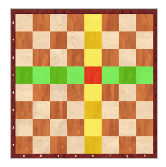Stereotyping the chess player in modern society
by Dr. Uvencio Blanco Hernández

A stereotype is a mental image
Today, in the age of information, communications and knowledge, our actions are surrounded by a large number of elements, characters and clichés, many of them predictable and shared by the majority, which come from different media such as television, press, cinema, books, advertising, networks and platforms associated with the Internet. They surround us, put pressure on us and permanently influence our decision making. We are talking about stereotypes. According to Quin & McMahon (1997), a stereotype is:
“A conventional image or popular prejudice about different groups of people. In this sense we can find different typologies of stereotypes, for example: gender, nationality, race, class or group stereotypes. Stereotyping is a method of categorising different groups by their appearance, behaviour, customs or gender. Thus, when the most characteristic features of a group are identified, they are used to represent the group as a whole, giving rise to a stereotype classification, which can be good or bad. All these deductions lead us to affirm and establish that behind stereotypes we find different value judgements”.
This implies that stereotypes represent generalisations that are embodied by different social groups and that society is therefore exposed to them permanently and with almost no control over them. For the most part, they are “systematised beliefs, internalised by everyone unconsciously, which conceal different value judgements. In this way, invisible codes are established by which society is suggested how it should behave or what role it should follow, but more importantly, how it should be (Quin & McMahon, 1997). Now, if stereotypes are very simplified and collective mental images or constructions, can they reach athletes? Yes, as we can find in boxing, artistic gymnastics, sumo or chess. In all of them, there are stereotypes that are quite widespread in our society.
What is the stereotype of chess players in modern society?
We can. help to raise the intelligence levels of our students and help them to succeed in a wide variety of subjects. Since the end of the 19th century, public opinion has generally accepted the idea that chess promotes the mental development of its players. That it strengthens basic processes such as perception, attention, memory, etc. But it also stimulates more complex skills such as logical, creative and critical thinking, as well as problem solving and decision making.
So why does society think that chess can stimulate mental skills?
In general, society has long regarded chess as a way for children to increase their mental dexterity, concentration, memory and analytical skills. To anyone who has known the game, it is not surprising that these assumptions have been tested in several studies on how chess can improve students’ grades. Furthermore, playing chess is fun; if children associate school and learning with fun, then they are more likely to develop a greater attachment to school.
Furthermore, research in this field has shown that there are many links that can be made between the game and psychology. In fact, some experts believe that chess is a test of patience, nerves, willpower and concentration. It improves your ability to interact with other people. It tests your sportsmanship in a competitive environment. On the other hand, there is a very strong perception regarding the connection between chess and intelligence. It is a social value, probably initiated around the 16th century. It is unique, enduring and strong. Some authors estimate that society perceives a powerful connection between playing chess and being smart. This can be very positive for young children, who, rather than being bullied as many adults are, embrace the notion. As children get older, a stigma or nerd factor attaches to “being smart”.
Source:
Blanco, U. (2020) “Ajedrez, ciencia cognitiva y educación”
Quin, R., & McMahom, B. (1997). Historias y estereotipos. Madrid.
Ediciones de la Torre.

